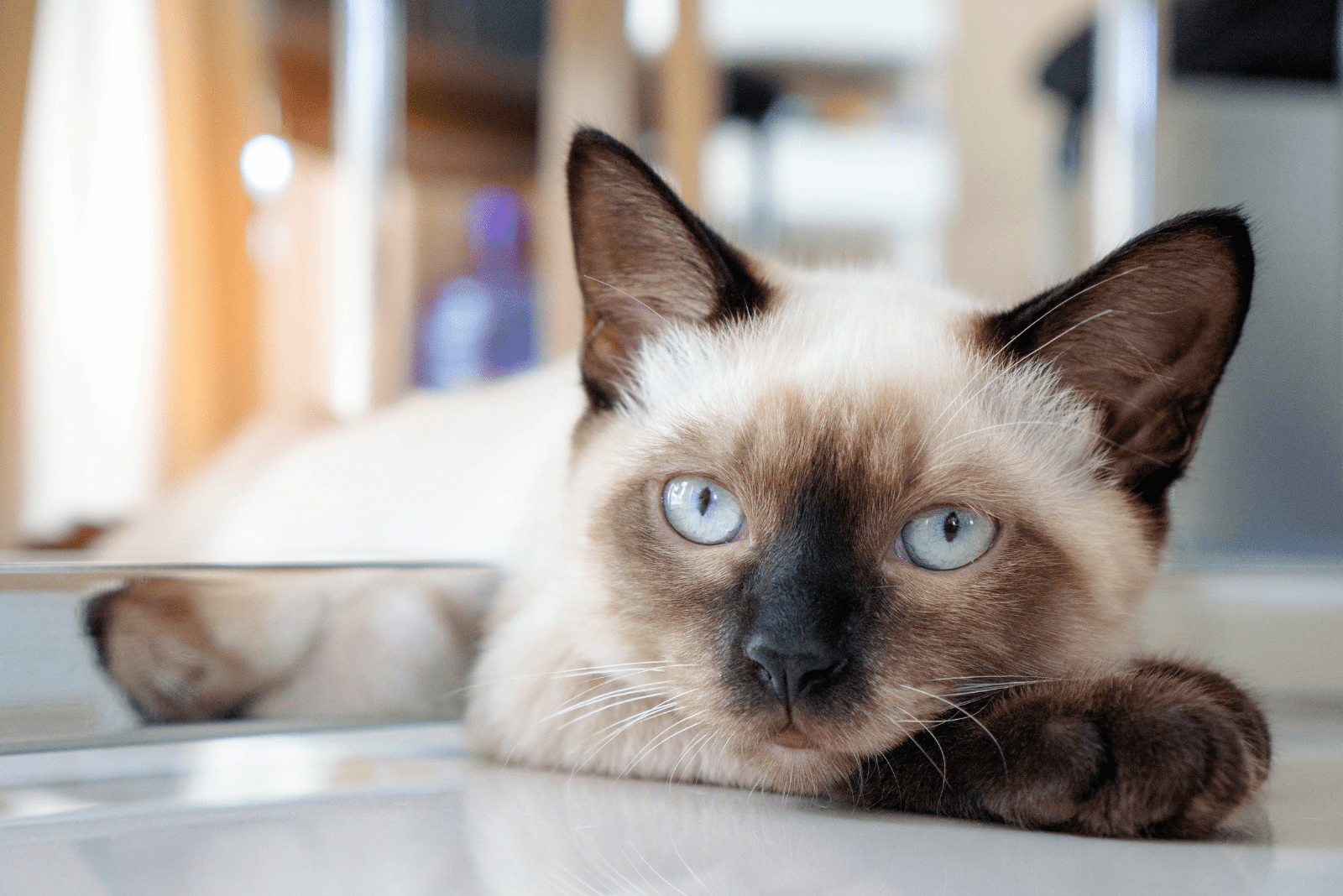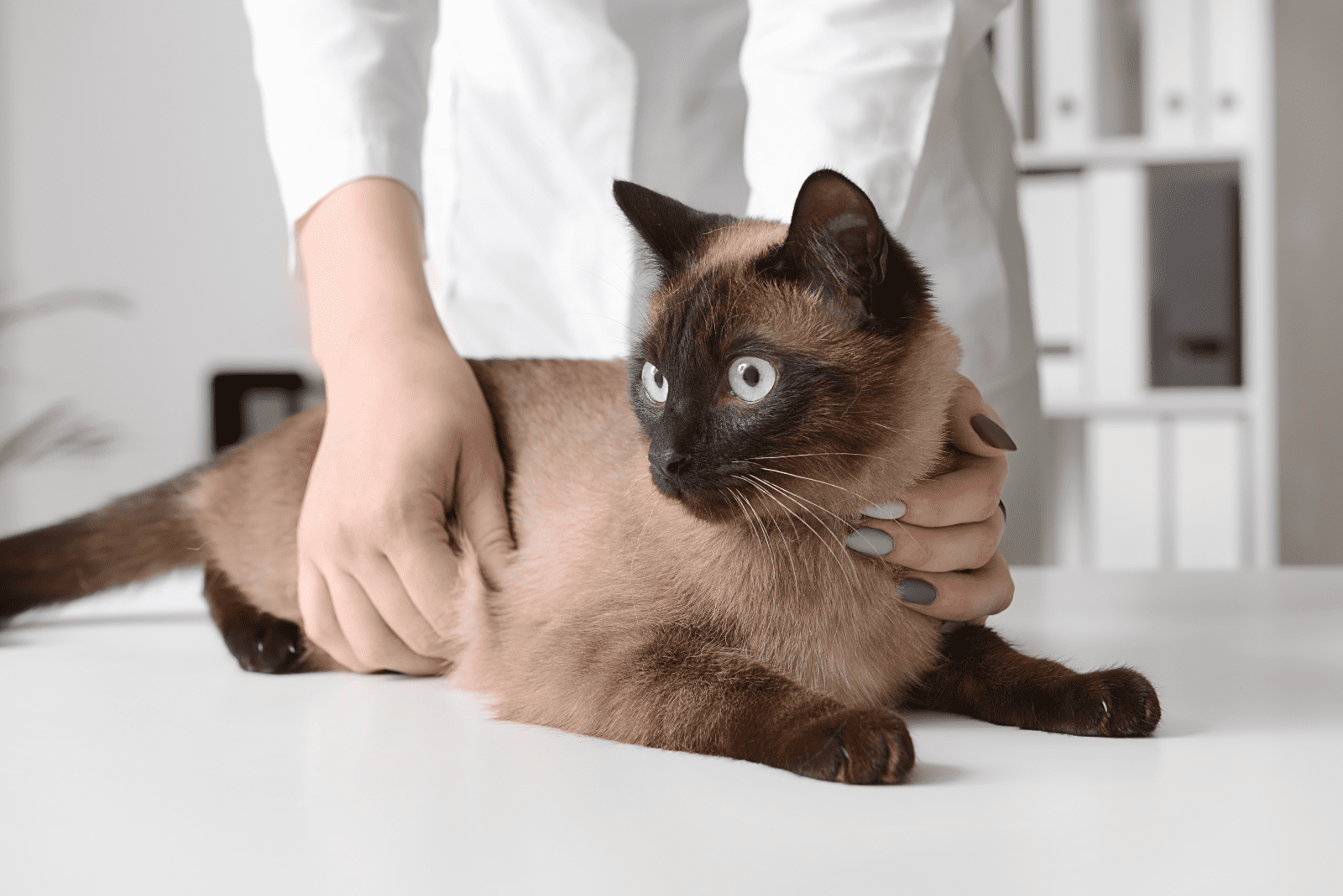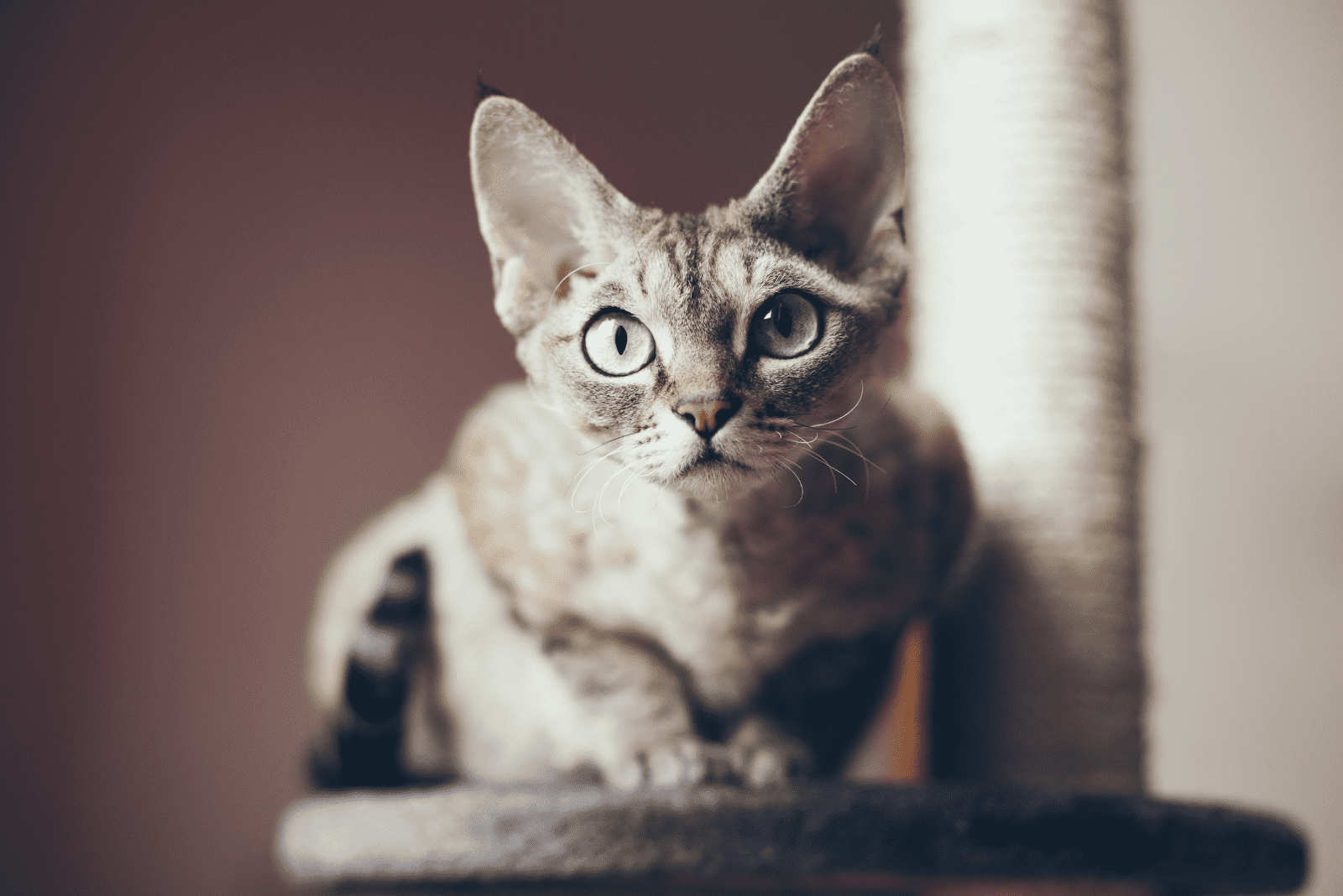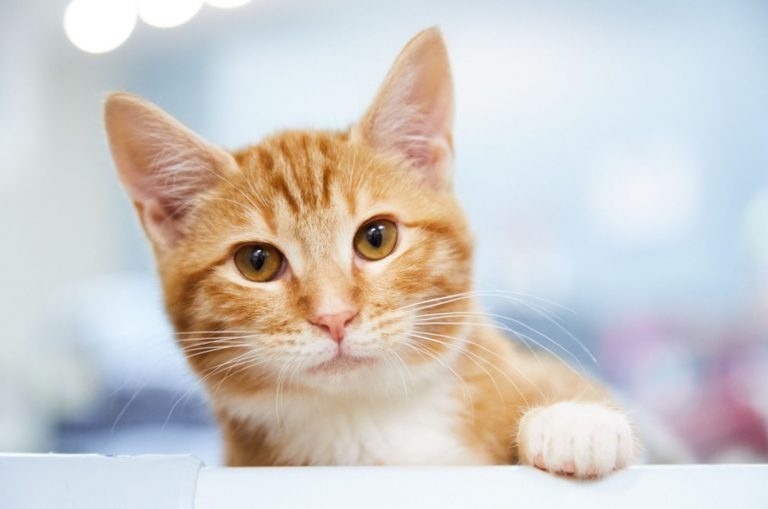Are Siamese Cats Hypoallergenic? Here’s An Explanation

Siamese cats are one of the most popular domestic cat breeds. They have a beautiful appearance that is characterized by their colorpoint shorter hair.
Although a bit chatty, Siamese cats have lovely personalities. But what about their grooming care? Do Siamese cats shed a lot? If not, are Siamese cats hypoallergenic?
There are a lot of things that many people with cat allergies want to know. Real Siamese cat lovers know that they have a lot of hidden superpowers.
So, if you want to find out if being hypoallergenic is one of them, keep reading and find out if a furry Siamese can make you happy after all!
Are Siamese Cats Hypoallergenic?
First things first, there’s no such thing as hypoallergenic cats. Every cat produces a protein called Fel d1 that triggers allergies, and it’s usually found on the cat’s skin, saliva, and urine.
The main difference is that some cats have higher and some have lower protein production.
So, if you wonder, are Siamese cats hypoallergenic, the answer is – not entirely as they still produce that protein.
They are considered hypoallergenic because of the lower production of the protein that is responsible for cat allergies in humans.
Things That Make Siamese Cats Almost Hypoallergenic

Siamese cats are not the most hypoallergenic cats, but they’re considered hypoallergenic because they don’t produce high amounts of the protein responsible for allergic reactions.
As this protein can be found in a cat’s saliva, when cats groom themselves, they leave their saliva on their coat that later sheds and may irritate people with sensitivities.
Also, the cat’s skin may produce dander that falls out along with the loose hair, and this also causes allergies.
Luckily, Siamese cats are considered hypoallergenic because they have lower shedding levels, which means that they don’t spread a lot of allergens around your environment.
Of course, like every other cat breed, Siamese shed a bit more during the shedding season, which happens twice a year. However, these furry friends are safer for allergy sufferers than some other cat breeds with higher protein production.
However, if you want to have a Siamese cat, here are some additional tips that can make your life with Siamese easier.
Tips For Allergy Sufferers On Taking Care Of Their Siamese Friend
If you’re an allergy sufferer who wants to enjoy time with a Siamese pet, you have to pay more attention to your cat’s grooming and maintaining your environment.
Brushing
So, first, Siamese cats don’t shed a lot, but it’s still important to brush them often to get rid of the dander and the cat’s loose hair and prevent it from spreading around your environment.
That way, your kitty will look happy and well-groomed, and it won’t have a lot of hairball issues but also, you’ll be satisfied as your cat won’t leave a lot of allergens around.
Try brushing your cat outside to minimize the risk of allergens spreading around your home.
It would also be great if someone who doesn’t have allergies would brush your feline, especially if you have more severe allergies. If you don’t have anyone else, make sure you use gloves, and wash your clothes and hands after grooming tasks.
Bathing
Most cats aren’t fond of baths but you gotta do what you gotta do! It’s important to bathe your feline often if you’re an allergy sufferer.
By bathing your cat, you’ll reduce the amount of loose hair and dead skin and keep your cat’s coat in good condition. Additionally, your kitty will often be clean and even fluffier.
Top-quality Diet
A perfect diet will keep the cat’s coat in a perfect condition. The cat may shed and groom itself less, which will result in fewer allergens around your environment.
What Are The Symptoms And Causes Of Cat Allergies?

Every person with cat allergies should know what exactly causes cat allergies. Is it the cat’s hair or is it more complex? It’s also good to know what symptoms may appear due to cat allergies.
So, keep reading and find out what are the main culprits for cat allergies and what symptoms you may experience. If you notice any of these symptoms, it would be best to consult with your doctor.
The Main Culprits For Cat Allergies
The Fel d1 protein, which causes allergic reactions, is present in a cat’s saliva, urine, and skin.
Cats leave their saliva on their fur while they groom themselves. After that, Fel d1 protein, which is the main cause of allergic reactions in people, is produced by the cat’s skin in the form of dander.
Dander falls out from the cat’s fur when they shed and spreads throughout your home and the air along with their hair, raising the risk of respiratory allergies.
A cat’s urine has been shown to contain the Fel d1 protein. Therefore, be sure to clean the cat’s litter box and replace the litter more frequently if you want to avoid breathing problems or other allergies.
However, if you are more sensitive to skin allergies, particular reactions, such as skin rashes, could occur after coming into contact with the cat’s saliva on their fur.
Signs That You Have Cat Allergies
As soon as you notice these symptoms after being in contact with a cat, you should visit your doctor as it may be a sign of cat allergies.
These allergies can be either mild or severe. In any case, if you’re a cat owner you’ll probably have to change your lifestyle a bit, if you want to keep your feline friend. However, in case of severe allergies that may be a bit harder. However, with a good doctor, and proper therapy, you and your feline should be good.
So, check out the following symptoms of cat allergies.
• Red, itchy eyes
• Watery eyes
• Sneezing
• Coughing
• Skin rash
• Runny or congested nose
• Breathing difficulties
• Anaphylaxis (only in severe cases)
If you’re a cat owner who has experienced some of these symptoms, keep reading to find out how to deal with cat allergies.
ALSO, CHECK OUT: Do Hypoallergenic Black Cats Exist? Assessing 22 Cat Breeds
Dealing With Cat Allergies

If you’re a cat owner with cat allergies, you don’t need to rehome your feline friend. Also, if you’re a cat lover, you don’t have to forget about getting one because of your allergies.
Of course, I suggest you consult with your doctor on getting a pet cat and follow his advice as he knows what’s best for you.
If the doctor says that you can get or keep a cat, then check out the following tips on how to deal with cat allergies, and also check out which cat breeds are the best for people with cat allergies.
Bathe Your Cat Often
To minimize the number of allergens, it’s essential to bathe the cat often to reduce the dander and oils on a cat’s skin that may cause allergic reactions.
By bathing your cat, you’ll keep its coat soft, clean, and in a healthy condition. Moreover, you’ll also help the cat to reduce loose hair, thus reducing the shedding level of your cat.
Brush Your Cat Regularly
Grooming is an important part of a cat’s care regardless of whether you’re an allergy sufferer or not.
Regular brushing will reduce the amount of shedding of your cat’s coat, which means that you’re going to minimize the risk of possible allergic reactions.
So, if you brush your cat regularly, your feline friend will groom itself less often, which is very important for you if you have cat allergies.
Let Someone Else Groom Your Cat
If you’re an allergy sufferer, it may be risky to groom the cat by yourself. The risk of allergic reactions is higher, as you’re exposed directly to cat allergens, that is dander and saliva.
So, to reduce the risk of having allergic reactions, it’s better to have someone else groom the cat for you.
In case you don’t have anyone that could do the job, I suggest that you use gloves and a mask while grooming the cat, and of course, wash your hands and clothes afterwards.
An additional tip to reduce the risk of allergies even more is to do the brushing part outside in order to prevent the loose hair spreading through your environment.
Wash Your Hands After Touching The Cat
It’s vital to wash your hands thoroughly after grooming, petting, or cleaning your cat’s things. This is essential if you want to avoid certain allergic reactions.
You should be careful not to touch your face, especially eyes, nose and mouth after interacting with your cat.
Pay Attention To The Cat’s Diet
If you want to reduce allergies, then you should also pay attention to the cat’s diet. As it’s essential for a cat’s overall health, it’s also crucial for your health and environment.
A cat needs a healthy and balanced diet, because a healthy diet will result in a healthy cat’s skin and coat.
With proper diet, cats may shed less, and also they may have less hairballs, especially if consuming food that is formulated to reduce the number of hairballs.
That’s also important because cat’s hairballs may also cause you allergic reactions due to their saliva.
Clean Your Environment Often
To have an allergy-free home, you need to clean your environment often. That means that you should vacuum your environment at least once a day to get rid of as much cat hair as you can.
Ensure that you vacuum every corner of your home, especially your feline’s favorite spots. You should also clean all the smooth surfaces, and wash the blankets or similar things where your cat likes to rest.
Of course, it’s preferable if you have someone else to do this task for you, but if not, make sure you use protection to minimize the risk of allergic reactions.
Use A HEPA Air Filter
The gadget that every cat owner with allergies should have is a High Efficiency Particle Air (HEPA) filter.
This gadget is perfect because it captures all the airborne allergens, such as skin flakes and hair, and prevents them from escaping.
As the air passes through, the allergens are captured, and fresh air comes out providing you with an allergy-free environment.
Use Dander-Removing Wipes

Another suggestion to minimize allergies is to use dander-removing wipes. Although these aren’t as good as the HEPA air filter, these wipes can be helpful, especially if you follow all the previously mentioned steps. The dander-removing wipes reduce the amount of dander and result in less shedding.
Filtrate Your Environment Frequently
With or without air purifiers, the best thing to reduce allergies is to filtrate your environment frequently. That way, you’ll provide your home with fresh air and the possible allergens are removed.
Change The Cat’s Litter And Wash The Litter Box Often
Previously, it was mentioned that a cat’s urine may contain the protein Fel d1 that causes allergic reactions in humans. That means that you should pay more attention to the cat’s litter box.
It’s important to change the cat’s litter frequently, and wash the litter box thoroughly before putting new litter in it.
Also, you should put the cat’s litter box in a special room or spot that will be reserved for your cat only, so that you won’t be exposed to it as much.
Don’t Let Your Cat Into Your Bedroom
If you’re an allergy sufferer, another thing you can do is to limit your cat’s movement. That includes not letting your cat into your bedroom, especially to sleep with you, as that may be worse for your allergies.
Provide the cat with its own space along with its necessities, but ensure that that space isn’t your bedroom.
Choose A Female Cat Or Neutered Male Cat
If you have cat allergies but your passion for cats is stronger, then you should be careful when choosing the perfect cat breed for you.
Although real hypoallergenic cats don’t really exist, there are some cat breeds that are recognized as hypoallergenic due to their lower dander productions. Besides that, you should also pay attention to the cat’s gender.
According to some research, light-colored female cats produce lower levels of the protein Fel d1 than male cats.
If you still want a male cat to be your pet, then make sure it’s neutered, as it has been proven that neutered male cats produce lower amounts of Fel d1.
Consult With Your Doctor
Finally, the most important thing when you have cat allergies, or any other type, is to consult with your doctor. You shouldn’t treat it on your own, so it’s important to follow the doctor’s instructions.
In the case of mild allergies, the doctor may prescribe you certain antihistamines that will help you manage the allergies.
However, in the case of severe allergies, the doctor may recommend immunotherapy.
You should know that allergies cannot really be cured, however, these medications and therapies may help you live your life with allergies more easily.
READ ALSO: Are Bengal Cats Hypoallergenic? Here’s What You Need To Know
The Best And The Worst Cat Breeds For Allergy Sufferers

So, if you’re an allergy sufferer but still want a pet cat, then here’s something that can help you. Even though there are no truly hypoallergenic cats, some cats are considered hypoallergenic because they produce less dander than other cat breeds.
Keep reading as this article provides you with a list of the best possible hypoallergenic cat breeds, and also with cat breeds that every allergy sufferer should avoid no matter if they have mild or severe allergies.
Possible Hypoallergenic Cat Breeds
• Sphynx cat – the reason why Sphynx cats are considered hypoallergenic isn’t because they’re almost hairless but because they shed less and produce lower amounts of dander that causes allergies. These hairless cats may require more grooming care than some cat breeds with longer coats.
• Devon Rex – these cats require minimal grooming care because of their short coats. Additionally, they have a low shedding level and a lower production of allergens, making them perfect feline pets for allergy sufferers.
• Cornish Rex – just like Devon cats, Cornish Rex cats also have short coats with less shedding. That is why these cats, with proper grooming care, can be purrfect pets for people with various sensitivities.
• Javanese (Balinese) cat – what makes these cats hypoallergenic isn’t their medium-long coats, but the absence of an undercoat. Therefore, Javanese cats produce less allergens and the risk of allergic reactions is minimal compared to other cat breeds.
• Oriental Shorthair cat – these cats are characterized by short coats. They also produce less dander, but they require frequent grooming to be safe for people with cat allergies.
• Siberian cat – this is one of the long-haired hypoallergenic cats. Although many people wouldn’t say that these cats are hypoallergenic, it’s actually true because they contain lower enzyme levels in their saliva to trigger allergies.
• Russian Blue cat – with their short coats and lower shedding levels as well as less dander, these cats are also considered hypoallergenic.
• Burmese cat – these cats tend to produce a lower number of allergens, which makes them possibly hypoallergenic cats.
Cat Breeds That Every Allergy Sufferer Should Avoid
Long-haired cats aren’t necessarily responsible for cat allergies because it’s not the hair that causes them.
However, these long-haired cats that I’m about to mention have a higher production of protein Fel d1 that is responsible for causing allergies and a higher amount of shedding. So, check out which cat breeds allergy sufferers should avoid!
• British Longhair cat
• Persian cat
• Long-haired Manx cat
All In All
Being a cat parent is awesome, but what if you like cats and have cat allergies? That may be very hard to manage.
However, with the right cat breed and by following special tips on how to be a responsible pet parent and deal with cat allergies, you can make it work.
Most allergy sufferers are looking for the perfect cat breed for them. Knowing that Siamese cats are one of the most popular cat breeds, the question is: are Siamese cats hypoallergenic?
Don’t worry, the answer is not so disappointing. First, there’s no such thing as a hypoallergenic cat – wait for it – but some cat breeds are considered hypoallergenic due to the lower production of protein Fel d 1 that causes allergies and less shedding; and the Siamese cat breed is one of them.So, if you want to have a Siamese cat, this article provides you with special tips on how you can live with your feline friend normally and decrease the risk of possible allergic reactions.
Like this post? Share or pin it for later!







